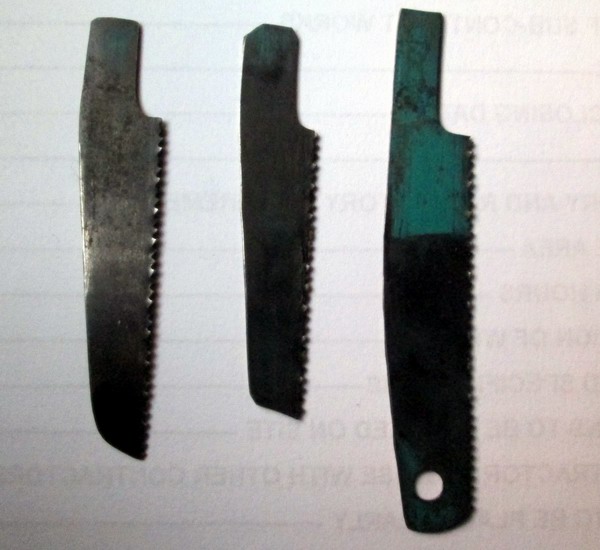Loading page header ... or Your browser does not support JavaScript
How do I cut those panels out?In the Lofting article we marked up a lot of plywood sheets, ready to cut. I usually start with the hull panels; that clears a lot of plywood out of the way. The smaller parts often fit on the offcuts, which I cut out later.On the internet you will read about various different approaches to cutting plywood, including circular saw. My favorite is still the jig or saber saw. The system I developed is to make my own blades from bi-metal hacksaw blades. Either end of the blade is usually still good as one tends to wear out the middle part first, so no need to cut up a new blade. Hacksaw blades come in 24 and 18 teeth per inch (tpi). I have found that 18 tpi is the most suitable for plywood work. Due to their hardness, the home-made blades last far better than the shop bought variety. Typically I can cut all the plywood parts for a dinghy on one home-made blade. My jigsaws so far have been Black & Decker and Ryobi's for the simple reason that the blade ends (shanks or foot) are straight, unlike the Bosch system. The straight ended blades are easy to make from hacksaw blades by grinding them to shape on a bench grinder. The blade should angle a bit forward from the blade foot. I make them a bit wider than the commercial jigsaw blades, as most cuts are quite gentle, long curves and the wider blades cut fairer. If required, making up a narrower blade for sharper curves takes a few minutes. After a little practice it is possible to cut very close to the line or practically on it. The cut with an 18 tpi blade is quite fast and cleaning up time with a sharp plane is minimal. A couple of strokes should fair up the edge and bring it to the line. On the topic of planes, you should only use a sharp plane (or chisel!) for whatever work you do. This topic is actually worthy of a separate blog. Sharpening is quick and easy once you know how. Not knowing how and thinking it takes too much time is the prime cause for delaying the sharpening exercise. Plywood blunts tools quickly. A blunt plane is hard to work and makes a mess of the work. So as soon as the plane gets harder to work, sharpen it. |
|

|
|
|
Picture of a few blades, some worn... |
|
|
So far I have described lofting and cutting parts out, but have not yet mentioned that there is one huge time saver as certainly the hull panels come in port and starboard sides. Some of my designs use P&S bulkhead halves and whatever part is mirrored, you only have to make up once by the methods described. The second half will be duplicated by using the first half as template. What you do is, place the original on the ply, mark out fairly roughly by tracing around. Cutting out is equally 'rough' i.e. slightly oversize. That cut is super fast as you don't have to cut close to the line. You then clamp the finished, original part to the rough cut one and either plane it down to match or use a hand-held router with a flush trim bit to accurately shape the second part. If you intend to finish by planing, you would try to cut closer to the line to have less finishing work. For router finish, several millimeters (1/8" or more) is fine as it trims off quickly. For internal cut-outs on bulkheads you can use a circle cutting attachment on a router to cut the arcs, then do the straight cuts with the jigsaw. (Circle cutting attachment"). For finishing cut-outs I like to use a drum sander in a drill. They are easily made up, see A cheap home-made drum sander" Within a short time you will have a lot of panels that are ready for the next step in the building process. |
Loading first page footer ... or Your browser does not support JavaScript
Loading second page footer ... or Your browser does not support JavaScript